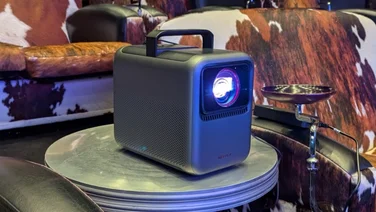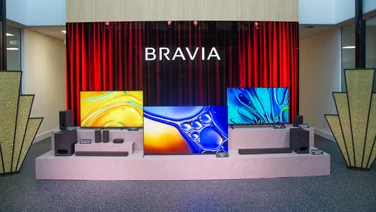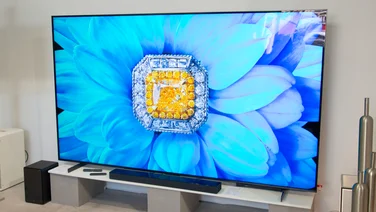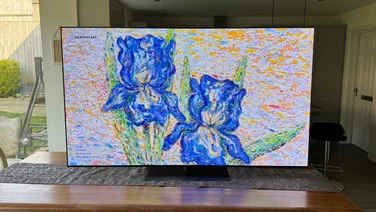To help us provide you with free impartial advice, we may earn a commission if you buy through links on our site. Learn more




Although all TVs are widescreen, their 16:9 aspect ratio is designed for broadcast TV rather than films, leaving you with black bars across the top and bottom of the screen when you watch movies. To address this, Philips has come up with its Cinema 21:9 range.

These, such as the 58in 58PFL9955H we’re reviewing here, have an aspect ratio of 21:9 (2.39:1), which is the same as a high proportion of films. For those interested, a lot of modern films are marked as having an aspect ratio of 2.35:1, but this is incorrect and only older movies used this format; however, the term remains as a general industry term, even though 2.39:1 is correct.
Adding to the cinema experience of this TV is 3D with a built in transmitter. It’s good to see that you get two pairs of active shutter glasses in the box, although at near-on £4,000 we’d be disappointed if this wasn’t the case.

The first thing to note is that the 58PFL9955H is one hell of an imposing TV. It’s absolutely humongous and incredibly wide. With the usual slick Philips styling, this is certainly a TV that you’d be proud to have in your living room.
Performance is everything, so we were keen to get some test movies out and see how the 58PFL9955H performs. It’s important to note that this TV has a resolution of 2,560×1,080, so to fill the screen the image has to be stretched. Also, if the input is not a 21:9 image, then filling the screen requires some clever algorithms in order not to distort the image.
We have to say that it does a really good job. Pushing a 21:9 film to fill the entire screen is done with no evidence of any scaling artefacts or distortion. It’s great to see a film without any black borders, filling the entire screen, as it makes it a more immersive experience.
If the source material isn’t 21:9, it has to be stretched to fill the space, throwing out its aspect ratio. However, there are a range of ways that the TV can do this, including just stretching the sides of the image, leaving the centre alone. The result of this is that you don’t perceive that the final image is distorted, as you concentrate on the centre of the screen.
Some of the modes perform a vertical stretch, too, which can put Blu-ray menus and on-screen status messages slightly off-screen. You can manually move the image for the latter, but for films with subtitles, there’s a mode that re-introduces the black bar at the bottom for undistorted text.
For those that like full control, you can adjust the exact stretch in the menus, or even return the image to native, placing black bars down the side of each frame. There’s also an autofill mode, which adjusts the picture on the fly depending on the source material. This is handy for some films, such as The Dark Knight, which switches from 21:9 in most scenes to a full 1080p 16:9 aspect ratio for the scenes shot for IMAX.
Impressively, watching TV, the Cinema 21:9 does a brilliant job upscaling and stretching an image to fit. All of the Freeview material we watched looked brilliant, with few artefacts and detail still evident in the final image. It’s slightly annoying that on a TV this expensive there’s no Freeview HD tuner. There’s a DVB-S satellite tuner built in and can receive all of the free-to-air channels on Freesat, but not the HD channels and you won’t get the same EPG as on a Freesat-branded product.
We’re not big fans of the programme guide for Freeview TV. We found it slow to use and there wasn’t a preview window, so you can’t see what you’re watching. It was also a bit slow to navigate, which is true of other parts of the interface at the time, and only shows around an hour’s worth of viewing on screen.
Still, it can be argued that this isn’t that important as this TV is designed for home cinema and it’s here that it really shines. Thanks to a local dimming LED backlight, there’s an array of more than 1,000 LEDs in 288 segments that can be controlled individually. The result is that part of the image can be pitch black, while another part bright white.
Watching the opening scene of Casino Royale, we noticed that this is the best contrast that we’ve ever seen on an LCD TV. We’d even go so far as to say that it approaches the quality of the best Plasma TVs. There’s also the full vibrancy of LCD, so colours are bright and lively, jumping out at you. It really is a joy to watch films on this set.
Switching to 3D, things weren’t quite as good as we’d hoped. Although this set has a 400Hz panel, it’s really a 200Hz one with backlight scanning on it to help improvement motion and movement. It’s also supposed to reduce crosstalk, where one eye sees the other eye’s image. Sadly, we didn’t find that this was the case.
Crosstalk was particularly noticeable when viewing vertical objects against a bright background, such as a tree or lamp-post against a blue sky. It’s not the worst example of crosstalk that we’ve seen, but Panasonic’s plasma 3D TVs have much faster panels so virtually eliminate the problem. We quite like the Philips glasses, though. They’re comfortable to wear and automatically synchronise with the TV without the need to press a fiddly button to turn them on.

Ambilight Spectra 3 helps push the image out of the TV, by matching coloured lights on the sides and top of the screen to the on-screen action. We’re big fans of this technology, as it helps create a more immersive experience; however, in 3D the extra light can be a bit distracting due to the shutter glasses causing flicker, so we turned it off for 3D only.
As with previous Philips TVs there’s the Perfect Pixel HD engine, which can help boost resolution (sharpness), contrast and colour. It also has a Perfect Natural Motion mode, which generates extra frames to make on-screen action appear smoother. The Medium or Minimum modes are more natural, in our opinion, but purists will want to turn this off and go with the source frame rate.
Sound quality is really good for a TV thanks to the rear-facing stereo speakers. Sound was buoyant and full of life, and there’s even a fair amount of bass on offer. Admittedly, if you’re going to watch a film you’ll have a surround-sound system, but for watching TV or using other sources of entertainment it’s great to have this kind of sound on tap.
There are quite a few nice touches. When you first set up your TV a wizard takes you through a series of split-screen images to help you choose which settings you prefer the look of. The results are automatically fed into the TV to get the best results. It may not be as scientific as using a colour calibrator, but it does help you get an image that you like personally.
We like the way that you can also assign inputs to a type of device with a matching icon, such as Blu-ray player. Once done this makes it easy for all members of your family to choose what input they want to use, without having to resort to arbitrary input labels, such as HDMI1. That said, if you plug in an ad-hoc product into a port, there doesn’t seem to be any way to change input on the fly without adding it as a new device. This seems to be because the wonderful-looking remote has very few buttons on it and is primarily designed to navigate through the TV’s menus.

As with the vast majority of modern TVs, there’s an Ethernet port. This can be used to stream music, videos and photos over your network from a UPnP server. It played our DivX files, but wouldn’t touch our WMV HD files, saying that the format wasn’t supported.
There’s an online portal where you can add new apps to the TV, but beyond YouTube and Picasa, there’s not that much on offer. There are no catch-up TV services and Philips lags behind Sony and Samsung in regards to online TV. It can be argued that internet TV on a screen such as this is largely irrelevant. Besides, adding better features is easy just by buying a Sony or Samsung Blu-ray player.
All of this adds up into a bit of a dilemma about how to rate this product. On one hand it’s not a particularly brilliant 3D model and the TV side is poor. On the other hand, the local dimming backlight, 21:9 aspect ratio and amazing image quality make this a truly desirable product.
Ultimately, the high price is one that’s hard to justify, when this amount of money could get you a fantastic projector for a much bigger screen. If you’re after a TV, the Panasonic Viera TX-P65VT20B (we’ve reviewed the 50in Viera TX-P50VT20B) has similar image quality, lower crosstalk on 3D, Freeview HD and Freesat HD built in. Our rough calculations show that while the Philips 21:9 TV has a total screen area of 1,215 square inches, the 65in Panasonic TV has a total screen area of 1,805 square inches, which can display a 21:9 image with a screen area of 1,375 square inches. It’s the better choice at this price.






